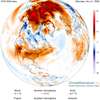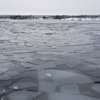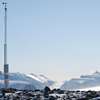
|

Thomas Nilsen /
The Independent Barents Observer /
November 22, 2020
A belt of warm air is currently stretching from northern Greenland across the North Pole to the Laptev and East Siberian Seas north of the Russian mainland. Northeast of Svalbard from Franz Josef Land to Severnaya Zemlya see similar heat. On a recent November weekend the average temperature was 6.7°C above normal across the Arctic.
Read article
on The Independent Barents Observer
|

|
Nome, Alaska, United States

Davis Hovey /
KNOM Radio Mission /
November 25, 2020
Similar to the last storm that hit the region earlier this month, there is hardly any sea ice in the Bering Sea to minimize the damage to coastal areas.
Read article
on KNOM Radio Mission
|

|
Vuorašjávri, Kautokeino, Finnmark Fylke, Norway

Marie Elise Nystad, Johan Ante Utsi /
NRK /
November 2, 2020
The reindeer owners feel they had to choose. Pay expensive fines or move with the reindeer across the river even if the ice was too thin. On Saturday, a thousand reindeer went through the ice in Vuorašjávri, a mile east of Kautokeino municipality in Finnmark.
Read article
on NRK
|

|
Vladivostok, Primorskiy, Russia
 Siberian Times
Siberian Times /
November 27, 2020
Video shows hero climbers manually breaking ice off its cable stays at height of 324m (1,063ft) in Vladivostok.
Read article
on Siberian Times
|

|
Reykjavík, Capital Region, Iceland
 RÚV
RÚV /
November 27, 2020
Roughly eight percent fewer drivers now choose to use studded winter tires on their cars than two years ago, according to FÍB, the Icelandic Automobile Association. It is worth noting that early winter this year has been mild and that some drivers may be holding off.
Read article
on RÚV
|

|
Mt. Juvvasshøe, Lom, Innlandet, Norway

Ragnhild Moen Holø, Even Lusæter, Roar Berntsen /
NRK /
November 30, 2020
Underground, a mighty giant is disintegrating: the permafrost is about to drop its roof. Constantly creeping upwards, the permafrost zone is now 100 meters further up the mountainside than 20 years ago.
Read article
on NRK
|

|
Yellowknife, Northwest Territories, Canada

Simon Whitehouse /
NNSL Media /
November 19, 2020
The Taltson River, below the hydro dam south of Great Slave Lake, typically sees 215 cubic meters per second. As of November 12, the water flow was recorded as 628 cubic meters per second.
Read article
on NNSL Media
|
The Northern Climate Observer is published by the
Center for Climate and Health. We track news coverage from across the circumpolar north and provide readers with a curated roundup of climate change related events. Thank you for reading our newsletter and for paying attention to our changing world.
Please forward this newsletter or share it on social media. Join the
LEO Network to share your own stories of environmental change.